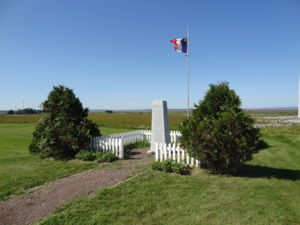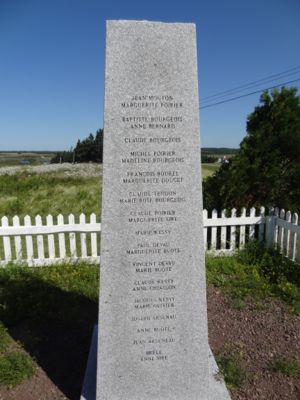- Profile
- Images
Location: 45.837827,-64.252937&z=13
"Beaubassin était un village en Acadie française fondé en 1671 situé sur l'isthme de Chignectou à proximité des marais salins de Tantramar aux abords de la rivière Mésagouèche. À l'époque, la région entière délimitée par les marais de Tantramar avait pour nom Beaubassin."[1]
"Beaubassin was the first settlement on the Isthmus of Chignecto, Nova Scotia, which was Acadian. The area is now known as the Tantramar Marshes. Beaubassin was settled in 1672, the second Acadian village to be established after Port Royal."[2]
Monument
Côté Est
- Jean Mouton
- Marguerite Poirier
- Baptiste Bourgeois
- Anne Bernard
- Claude Bourgeois
- Michel Poirier
- Madeline Bourgeois
- Francois Bourel
- Marguerite Doucet
- Claude Tendon
- Marie Rose Bourgeois
- Claude Poirier
- Marguerite Sire
- Marie Kessy
- Paul Devau
- Marguerite Buote
- Vincent Devau
- Marie Buote
- Claude Kessey
- Anne Chiasson
- Jacques Kessy
- Marie Olivier
- Joseph Arsenau
- Anne Buote
- Jean Arseneau
- Brélé
- Anne Sire
Côté Ouest
- Francoise Sire
- Jaques Bourgeois
- Marie Bourque
- Marie Chiasson
- Michel Bourgeois
- Marie Doucet
- Charles Heon
- Marie Jeanne Bourgeois
- Jean Kessy
- Marie Richard
- Paul Sire
- Oliver Bourgeous
- Pierre Cottard
- Agnes Bourgeois
Timeline
- C1671-1672 Village of Beaubassin on the Isthmus of Chignecto founded by Acadian surgeon Jacques Bourgeois, who persuaded five other families to go with him.[3][4]
- 1676-78 Michel Leneuf des Vallières is awarded a large (1000 square miles) seigneury at Beaubassin. “The grant specified that he leave undisturbed any settlers there, together with their lands they used or had planned to use for themselves”. La Vallière builds his homestead on an island (Tonge’s Island) [5][4]
- 1682 Eleven men are subpoenaed for refusing to accept the constracts of concessions: Pierre Morin, Guyou Chiasson, Michel Poirier, Roger Kessy, Claude Du Gast, Germaine and Guillaume Bourgeois, Germaine Giroir, Jean Aubin Mignaux, Jacques Belou, and Thomas Cormier. [4]
- 1687 War of the League of Augsburg (King William’s War) starts between England and France[6]
- 1696 Benjamin Church raids Beaubassin. Once the English ships were seen, the inhabitants fled, carrying their more valuable possessions. Church “…stayed nine days and in his own account …admitted that the settlers’ ”cattle sheep, hogs, and dogs” were left ”lying dead about their houses, chopped and hacked with hatches". The church and some of the houses were also burnt. [6]
- 1697 Treaty of Ryswick restores Acadia to France; Port-Royal is its capital[7]Dunn, Brenda. A History of Port Royal / Annapolis Royal 1605-1800. Nimbus Publishing, p 44-45</ref>
- 1702 War of the Spanish Succession (Queen Anne’s War) starts between England and France[7]
- 1704: Church raids Beaubassin again: “The Acadians were in arms and an indecisive skirmish ensued. After the Acadians retreated into the woods, Church and his men found that the inhabitants had removed as much of their household and farm goods as possible. Church set the buildings on fire [20]and killed about 100 cattle before leaving to return to Boston” [6]
- 1710 Siege of Port-Royal; French surrender the Fort. Port-Royal, Acadia becomes Annapolis Royal, Nova Scotia’’[7]
- ’’1713: Treaty of Utrecht. France cedes Acadia to England. Permanent British rule’’[8]
- 1714-15: A new English king requires oaths of allegiance.[6] Delegates from Beaubassin sign a conditional oath of allegiance, promising to stay true to the King of Great Britain for as long as they stayed in Nova Scotia, and to remain neutral in the event of a conflict between France and Great Britain
- 1720 and onward: Acadians refuse to sign an unconditional oath of allegiance. This is tolerated by the British as they lack military means to enforce the oath.[9]
- 1713-1744: Golden Age[10] of Acadian Growth and Prosperity. Beaubassin is productive in raising cattle, growing grain, and trading fur with the Mi’kmaq and Maliseet. Surpluses are traded with both the English (Bay of Fundy) and the French (Baie Vert).[11]
- 1750: Beaubassin is the center of a boundry dispute between the French and English. French soldiers erect small forts along their frontier at the north bank of the Mesagoueche river (now the New Brunswick- Nova Scotia border) including one at Beauséjour ridge. When British Commander Lawrence tries to gain a foothold on the river, the priests LeLoutre and Germain burned the Beaubassin church and force the villagers to burn their houses. The British retreated but eventually established fortifications on the south side. French soldiers order the Acadian families in the southern villages to move to the north side for their protection. When no one complies, the soldiers and Mi'kmaq warriors (of the priest LeLoutre) burn the southern villages. Most burnt-out families seek refuge north of the French-English boundary in territory surrounding Le Lac (Aulac NB).
Sources
- ↑ Contributeurs de Wikipédia, "Beaubassin," Wikipédia, l'encyclopédie libre, https://fr.wikipedia.org/w/index.php?title=Beaubassin&oldid=167054860 (Page consultée le février 4, 2020).
- ↑ Wikipedia contributors, "Beaubassin," Wikipedia, The Free Encyclopedia, https://en.wikipedia.org/w/index.php?title=Beaubassin&oldid=895616369 (accessed February 5, 2020).
- ↑ White, Stephen A. La généalogie des trente-sept familles hôtesses des Retrouvailles 94, online articles, Les Cahiers de la Société historique acadienne, vol. 25, nos 2 et 3 (1994), BOURGEOIS, page 1
- ↑ 4.0 4.1 4.2 Clark, Andrew Hill, Acadia; the geography of early nova Scotia to 1760. Madison: University of Wisconsin Press, 1968. p141 (Bourgeois founder); p141-142 (seigneury of Beaubassin)
- ↑ J.-Roger Comeau, “LENEUF DE LA VALLIÈRE DE BEAUBASSIN, MICHEL (d. 1705),” in Dictionary of Canadian Biography, vol. 2, University of Toronto/Université Laval, 2003–, accessed December 1, 2013.
- ↑ 6.0 6.1 6.2 6.3 Griffiths, Naomi E.S., From migrant to Acadian : a North-American border people, 1604-1755, Montreal (Québec), McGill-Queen's University Press, 2005, p147-151 (King William’s War); p 164 (1696 Church raid of Beaubassin); p 208 (1704 Church’s Raid on Beaubassin)); p 267-268 (oaths of allegiance)
- ↑ 7.0 7.1 7.2 Dunn, Brenda. A History of Port Royal / Annapolis Royal 1605-1800. Nimbus Publishing, p44-45 (1697 Treaty of Ryswick); p52-53(1702 Queen Anne’s War); p82-85(1710 Siege of PR).
- ↑ The Neutrality: Political Context, in 1755 l'Histoire et les Histoires, University of Moncton
- ↑ The Neutrality: Political Context, 1755 Histoire et Les Histoires, University of Moncton
- ↑ Griffiths, Naomie E.S. The Contexts of Acadian History 1686-1784.Published for the Center for Canadian Studies Mount Allison University, Montreal: McGill-Queens University Press, 1992, p61 (golden age);
- ↑ Régis Brun with contributions by AJB Johnston and E Clarke, "Fort Beauséjour/Fort Cumberland: Une Histoire/A History", Société du Monument Lefebvre in Collaboration with Parks Canada, PDF, accessed online in February 2020 at http://parkscanadahistory.com/brochures/beausejour/booklet-history-c1991.pdf
See also:
- "Nova Scotia Acadian Historic Atlas : History - Beaubassin", Canada's Digital Collections, accessed at http://epe.lac-bac.gc.ca/100/205/301/ic/cdc/neo-ecossaise/en/historique/beau.htm
- Kennedy, Gregory, Peace, Thomas, Pettigrew, Stephanie. "Social Networks across Chignecto: Applying Social Network Analysis to Acadie, Mi'kma'ki, and Nova Scotia, 1670-1751" (publisher and date unknown) Articleciting many sources
- Login to edit this profile and add images.
- Private Messages: Contact the Profile Managers privately: Cindy Cooper, Acadians Project WikiTree, Jacqueline Girouard, and Roland Arsenault. (Best when privacy is an issue.)
- Public Comments: Login to post. (Best for messages specifically directed to those editing this profile. Limit 20 per day.)





